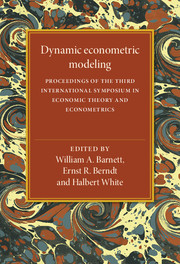 Dynamic Econometric Modeling
Dynamic Econometric Modeling Book contents
- Frontmatter
- Contents
- Editors' introduction
- List of contributors
- Part I Dynamic structural modeling
- 1 Efficient instrumental variables estimation of systems of implicit heterogeneous nonlinear dynamic equations with nonspherical errors
- 2 Envelope consistent functional separability
- 3 Flexible functional forms for profit functions and global curvature conditions
- 4 Likelihood inference in the nonlinear regression model with explosive linear dynamics
- 5 Exact inference in models with autoregressive conditional heteroscedasticity
- 6 Control of a linear regression process with unknown parameters
- 7 Some tests of nonparametric regression models
- Part II Linear time series modeling
- Part III Chaotic attractor modeling
- Part IV Applications
2 - Envelope consistent functional separability
Published online by Cambridge University Press: 03 May 2010
- Frontmatter
- Contents
- Editors' introduction
- List of contributors
- Part I Dynamic structural modeling
- 1 Efficient instrumental variables estimation of systems of implicit heterogeneous nonlinear dynamic equations with nonspherical errors
- 2 Envelope consistent functional separability
- 3 Flexible functional forms for profit functions and global curvature conditions
- 4 Likelihood inference in the nonlinear regression model with explosive linear dynamics
- 5 Exact inference in models with autoregressive conditional heteroscedasticity
- 6 Control of a linear regression process with unknown parameters
- 7 Some tests of nonparametric regression models
- Part II Linear time series modeling
- Part III Chaotic attractor modeling
- Part IV Applications
Summary
Introduction
For some time now, it has been known that homothetic functional separability, the consistency of sequential optimization, the existence of input price or quantity aggregates, and the equality of certain substitution elasticities involve similar, if not identical, restrictions on the underlying production or utility function. Because functional separability has such important implications, therefore, separability restrictions have been the focus of a variety of empirical studies.
The empirical and theoretical literature on functional separability in production or cost functions to date has been almost exclusively presented in the context of cases in which all inputs or commodities are hypothesized to adjust instantaneously to their long–run or full equilibrium levels. By contrast, in recent work on factor demand models it has become increasingly common to assume instead that in the short run certain inputs (such as capital plant and equipment) are fixed but that in the long run these quasi–fixed inputs are variable.
At least since the work of Viner (1931), it has been known that the firm's long–run average total–cost (LRATC) curve can be constructed as the envelope of tangencies with short–run average total–cost (SRATC) curves. In this chapter attention is focused on the following issues: If functional separability holds on the LRATC function, what restrictions are implied on the SRATC function? Similarly, what does functional separability on the SRATC function imply for the corresponding LRATC function? In brief, the envelope consistency of functional separability restrictions is examined in the context of cost functions.
Information
- Type
- Chapter
- Information
- Dynamic Econometric ModelingProceedings of the Third International Symposium in Economic Theory and Econometrics, pp. 27 - 42Publisher: Cambridge University PressPrint publication year: 1988